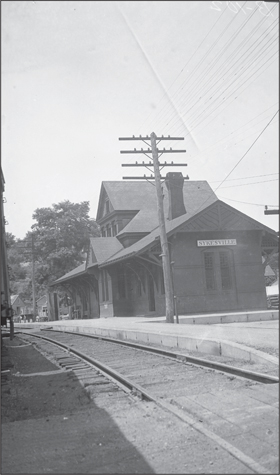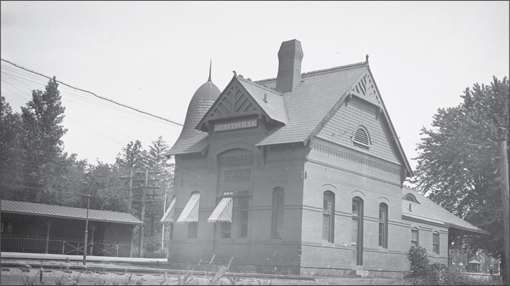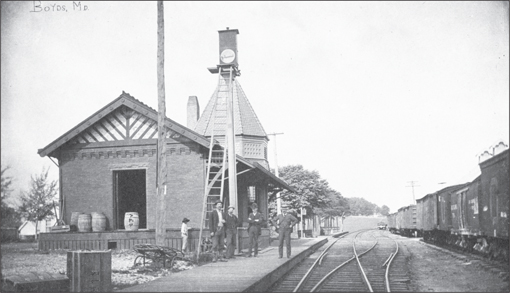Three
THE VICTORIAN B&O
1866–1900
Following the Civil War, the B&O entered a time of grand expectations and growth, but it also faced two periods of economic uncertainty. During this period, the modern B&O begins to emerge, as the line reached areas that would prove vital to its operations into the 20th century. Many of the buildings and stations constructed during this time would last well into the next century.
In Maryland, the Metropolitan branch opened between Point of Rocks and Washington, DC, in 1873, providing a more direct route from the capital to the west. It expanded northward from Cumberland to Pittsburgh, Pennsylvania, and westward to Chicago, Illinois. Baltimore City would see the completion of the Belt Line and Howard Street tunnel as it constructed its own route from Baltimore to Philadelphia. In the 1890s, a small portion of the Belt Line would be electrified, resulting in the first main line electrification of a railroad.
The railroad entered the resort business in the 1870s, opening hotels in Cumberland, Deer Park, Relay, and Oakland. A major station-building campaign occurred in the 1880s and 1890s, resulting in construction of many of the classic stations that still exist, like Sykesville, Oakland, Gaithersburg, and Mount Royal. These stations and depots provided the backdrop for everyday life, serving the rich and famous, Washington politicians, and the average man. From folks traveling to visit friends or family, to companies shipping goods, the railroad station was a hub and hive of constant activity.
The B&O suffered several major financial crises as well. Economic panic and poor working conditions resulted in the strike of 1877. What began on the B&O in Martinsburg, West Virginia, spread like wildfire to Baltimore and across the nation. A second crisis, in the 1890s, forced the B&O into receivership and left it under the control of its archrival, the Pennsylvania Railroad.

When the Patterson Viaduct was washed away in 1866, it was replaced by an iron truss, which was destroyed in the great flood of 1868. This would be replaced by a Bollman truss bridge. It stood until the track realignment and creation of the Ilchester Tunnel in 1908.

The B&O’s Mount Clare Shops are seen in this lithograph, “Edward Sachse’s Bird’s Eye View of City of Baltimore 1869.” It is easy to see, in the center of the image, the industrial center the shops had become, with multiple roundhouses and buildings. The angled buildings in the lower left are engine houses on the B&O’s right-of-way.

Ephraim Francis Baldwin (1837–1916) is best remembered in railroad circles for his designs of buildings and stations for the B&O. Baldwin began his career as a draftsman with the firm of Niernsee & Nielson, which designed Camden Station. He worked there until 1867. After a short partnership with Bruce Price, he entered private practice and was named the B&O’s head architect in 1872. In 1883, he partnered with Josias Pennington, who had been a draftsman at Baldwin & Price. The firm Baldwin & Pennington worked for the B&O for over 25 years, designing simple freight houses; large and small passenger stations, including Mount Royal Station, Sykesville, and Oakland’s depot; and the 1884 passenger car roundhouse at Mount Clare. He is also known for his nonrailroad work, including churches, schools, public buildings, and warehouses.

This west-facing photograph of the Sykesville station was taken by the railroad during the Interstate Commerce Commission’s efforts to value the railroad in 1920. The depot opened in 1884. It was described as 90 feet long and 28 feet wide, with a telegraph and ticket office between two waiting rooms. The upstairs contained offices. Today, the building is operated as a restaurant.

The B&O built the Viaduct Hotel and station in 1873 where the main line headed south along the Washington branch. The Gothic structure, designed by Ephraim Francis Baldwin, replaced the Relay House as the primary station, restaurant, and hotel. As dining and sleeping cars became more popular on the B&O’s line, the hotel’s business decreased. By the early 1900s, the building was being used for other purposes, including as a shelter for the B&O Relief Department. It was closed in 1929 and demolished in 1950.

Cumberland’s Queen City Hotel and station opened for business in the fall of 1872. It was one of five combination hotels and stations operated by the B&O. Designed by Thomas Heskett in the Italianate style, the hotel contained 174 rooms and was a summer resort on the B&O’s route to Pittsburgh. Covered platforms were added in 1912. The hotel closed to the public in 1964 and suffered a fire in 1969. The structure was torn down in 1972.

Located at the end of Elm Street and Locust Alley in Cumberland, Maryland, this rolling mill initially manufactured rail for the B&O’s track. Its design allowed the railroad maximum flexibility in the use of the facility and the arrangement of machinery necessary for the manufacturing process. Access to coal and a reliable labor force provided the B&O with an ideal location for the mill. It was demolished in 1981.

Built in 1873, the Deer Park Hotel opened in Garrett County, and the B&O trains provided service to this western Maryland oasis. One of several luxury hotels built by the B&O, it became a popular destination and retreat for politicians and presidents. Grover Cleveland and his new bride, Frances, spent their honeymoon at the hotel in 1886. The main hotel building is shown above. The hotel operations at Deer Park expanded in the 1880s with the addition of an eastern annex (below), a western annex, and several cottages. The hotel closed in 1929 during the Great Depression and was severely damaged by fire in the 1940s.


Point of Rocks was critical to the B&O’s plans to head west. Its proximity to the C&O Canal led to severe legal wrangling that held up construction until a compromise was reached in the 1830s. The station (above) was completed in 1875. Situated at the juncture of the B&O’s main line and the newly opened Metropolitan branch, it provided access to Washington, DC, without the necessity of going to Relay, Maryland, via the Washington branch. The station featured waiting rooms, a ticket booth, and a tower. It was renamed Washington Junction in 1876, as it was known when the photograph was taken in 1920. In 1923, the name reverted to Point of Rocks. The photograph below is an early view of the tunnel at Point of Rocks. Created shortly after the Civil War, it has been modified and is still in use today.


Named after the locust trees that were prevalent in the area, Locust Point became a major rail and shipping hub beginning in the 1840s, when the B&O built track and piers to accommodate larger ships than could be handled in Fells Point. The above photograph, taken about 1875, shows a grain elevator and piers Nos. 6, 7, 8, and 9. Piers No. 8 and No. 9 were constructed in 1867 and served as the point of entry for thousands of immigrants from Central and Eastern Europe. They traveled to Baltimore via the North German Lloyds Company, which partnered with the B&O. The arrangement helped make Baltimore one of the largest immigration reception points in the United States. The photograph below shows the large grain elevators. The hoppers are loaded with coal, another major natural resource shipped out of the facility.


This January 1876 timetable lists the arrival and departure times for westbound passenger and freight trains on the Washington branch. The stations along the line, largely rural at this time, would expand with the continued growth of the B&O to become thriving commuter and freight hubs. As with modern lines, there were express trains and those that stopped at every station, resulting in the different times on the timetable. Some passenger trains could make the trip from Baltimore to Washington in one hour and 30 minutes or one hour and five minutes.

The ornate Hyattsville station was one of the largest stations on the Washington branch between Washington, DC, and Baltimore when it opened in 1884. The structure was designed by Ephraim Baldwin in the Queen Anne style. When completed, it proved to be the center of a growing community nestled along two major routes of travel, the B&O and the Washington & Baltimore Turnpike.

The cover of the August 4, 1877, edition of Frank Leslie’s Illustrated depicts scenes along the B&O during the strike of 1877. The violence was pervasive and disruptive to B&O operations. Eventually, Maryland’s governor would call out the 5th and 6th Regiments of the National Guard. They were attacked on their way to Camden Station. The survivors would be used to control the situation and protect the railroad’s property.

Located on the corner of Baltimore and Calvert Streets, the B&O’s Central Office building was constructed in 1882 under the direction of John Garrett. When it was completed, the president’s office moved to the site, as did other functions, including record keeping. The ornate structure was reported to be fireproof; however, the fire of 1904 proved otherwise.

Mount Royal Station opened for service in September 1896 as part of infrastructure to support and connect Baltimore operations with Philadelphia. Designed by Baldwin, its exterior featured granite, limestone, and terra-cotta tiles in a mix of Renaissance and Gothic styling and a working clock tower. This postcard depicts the Maryland National Guard’s 5th Regiment returning from the dedication of Pres. Ulysses S. Grant’s tomb in April 1897.

This south-facing photograph looks into the train shed and the mouth of the Howard Street Tunnel at Mount Royal Station in the late 1890s. Construction of the tunnel began in 1890 and was completed in 1895. The 1.4-mile tunnel went directly under Howard Street. Electrification of the line was critical to its success and was accomplished in June 1895, marking the first main line electrification in the nation.

This early postcard shows the B&O’s Boyds, Maryland, station in 1892. The station was named after Col. James Alexander Boyds, a B&O construction engineer who worked on this section of the line. The station, built in 1887, was eventually removed in 1927 to make way for double tracking on the Metropolitan branch. In front of the station’s freight storage area is an early railroad signal accessed by a ladder.

This photograph looks west at the passenger platform built at Camden Station for trains using the Howard Street Tunnel. The platforms allowed for direct access to the tunnel, as the entrance was below street level. Prior to construction of the platform, trains had to back out of the station and then enter the track leading to the tunnel. The platform allowed trains to board passengers on the track leading directly into the tunnel.

B&O president John W. Garrett commissioned Francis Blackwell Mayer to paint an allegorical image of the most significant men involved with the B&O from 1827 to 1880. Mayer’s masterpiece was known as “The Founders of the Baltimore and Ohio Railroad.” Seated on the far left is Charles Carroll of Carrollton, guest of honor at the laying of the first stone, B&O director, and American patriot. A kneeling Samuel Morse, located in the center of the image, holds the tape from his first telegraph message. Standing just to the right of Morse, holding a model of the Tom Thumb steam engine, is its inventor, Peter Cooper. Seated on the far right is John Garrett, the B&O’s guiding force during and after the Civil War. The original painting hangs in the CSX corporate headquarters in Jacksonville, Florida. A reproduction is on display at the B&O Railroad Museum in Baltimore.

Photographers capture the B&O’s Royal Blue as it steams north over the Thomas Viaduct in the late 1890s. The Royal Blue was a luxurious passenger train operating between Washington, DC, and New York. Operated in conjunction with the Reading Railroad and the Central Railroad of New Jersey, the trains were fast, comfortable, and the premier passenger train of the day for the B&O.

Situated on the Washington branch, the Laurel station was originally called Laurel Factory. The current station dates to the B&O’s upgrades and building efforts of the 1880s. The depot opened in 1884 and was designed by Ephraim Baldwin. The building was gutted by fire in 1992, but it has since been restored, and it continues to serve the community as a MARC station.























